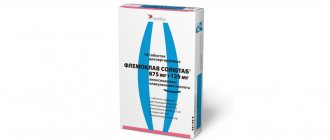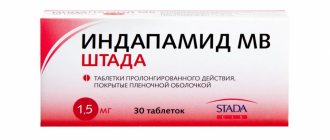Description of the drug
Suprax is a modern cephalosporin antibiotic. Used in the treatment of complex infections caused by gram-negative or gram-positive bacteria, as well as aerobic or anaerobic microorganisms. Shown to be effective against streptococcus and staphylococcus.
Produced in the form of capsules and suspensions. Both dosage forms of Suprax have the antibiotic cefixime as the main active ingredient.
Capsules contain 400 mg of the medicinal component. Excipients include silicon dioxide, azorubine, magnesium stearate, and cellulose. Sold 6 pieces in a cardboard box containing instructions.
Patients aged 6 months to 12 years need to purchase the medicine in powder form to make a suspension themselves. 5 ml of the finished medicine contains 100 mg of cefixime. The cardboard box contains one 60 ml bottle of white or slightly cream-colored powder, instructions for preparing the liquid form and a dosing syringe. The suspension additionally includes: sodium benzoate, xanthan gum, sucrose and flavoring.
Suprax
Release form, composition and packaging
Capsules with a yellow cap and a white body; the contents of the capsules are a yellowish-white mixture of powder and small granules.
| 1 caps. | |
| cefixime | 200 mg |
Excipients: colloidal silicon dioxide, magnesium stearate, carboxymethylcellulose.
Composition of the capsule shell: titanium dioxide, D&C yellow dye 10, FD&C yellow dye 6, gelatin.
6 pcs. - blisters (1) - cardboard packs.
Capsules with a purple cap and a white body, with the code “H808” printed on them; the contents of the capsules are a yellowish-white mixture of powder and small granules.
| 1 caps. | |
| cefixime | 400 mg |
Excipients: colloidal silicon dioxide, magnesium stearate, carboxymethylcellulose.
Composition of the capsule shell: titanium dioxide, D&C yellow dye 10, FD&C yellow dye 6, D&C red dye 33, FD&C blue dye 1, gelatin.
6 pcs. - blisters (1) - cardboard packs.
Granules for the preparation of oral suspension from almost white to cream color; The finished suspension is almost white to cream in color with a sweet strawberry aroma.
| 5 ml of ready-made suspension. | |
| cefixime | 100 mg |
Excipients: sodium benzoate, sucrose, yellow gum, strawberry flavor.
Dark glass bottles with a volume of 60 ml (1) complete with a dosing spoon - cardboard packs.
Clinical and pharmacological group: III generation cephalosporin
Registration No.:
- caps. 200 mg: 6 pcs. — P No. 013023/01, 11.04.07
- caps. 400 mg: 6 pcs. — P No. 013023/01, 11.04.07
- granules for preparation. susp. for oral administration 100 mg/5 ml: vial. 60 ml - P No. 013023/02, 04/11/07
pharmachologic effect
Semi-synthetic broad-spectrum cephalosporin antibiotic of the third generation for oral administration. Acts bactericidal. The mechanism of action is due to inhibition of the synthesis of the pathogen's cell membrane. Cefixime is resistant to the action of β-lactamases produced by most gram-positive and gram-negative bacteria.
In vitro, cefixime is active against gram-positive bacteria: Streptococcus agalactiae; gram-negative bacteria: Haemophilus parainfluenzae, Proteus vulgaris, Klebsiella pneumoniae, Klebsiella oxytoca, Pasteurella multocida, Providencia spp., Salmonella spp., Shigella spp., Citrobacter amalonaticus, Citrobacter diversus, Serratia marcescens.
In vitro and in clinical practice, cefixime is active against gram-positive bacteria: Streptococcus pneumoniae, Streptococcus pyogenes; gram-negative bacteria: Haemophilus influenzae, Moraxella (Branhamella) catarrhalis, Escherichia coli, Proteus mirabilis, Neisseria gonorrhoeae.
Pseudomonas spp., Enterococcus (Streptococcus) serogroup D, Listeria monocytogenes, most Staphylococcus spp. are resistant to the drug. (including methicillin-resistant strains), Enterobacter spp., Bacteroides fragilis, Clostridium spp.
Pharmacokinetic a
Suction and distribution
When taken orally, the bioavailability of cefixime is 40-50%, regardless of food intake, however, the Cmax of cefixime in serum is achieved faster by 0.8 hours when taking the drug with food.
When taking the drug in capsule form at a dose of 200 mg, Cmax in the blood serum is achieved after 4 hours and is 2 mcg/ml, when taken at a dose of 400 mg - 3.5 mcg/ml.
When taking the drug in the form of a suspension at a dose of 200 mg, Cmax in the blood serum is achieved after 4 hours and is 2.8 mcg/ml, when taken at a dose of 400 mg - 4.4 mcg/ml.
Binding to plasma proteins, mainly albumin, is 65%.
Removal
About 50% of the dose is excreted unchanged in the urine within 24 hours, about 10% of the dose is excreted in bile.
T1/2 depends on the dose and is 3-4 hours.
Pharmacokinetics in special clinical situations
In patients with impaired renal function, with CC from 20 to 40 ml/min, T1/2 increases to 6.4 hours, with CC 5-10 ml/min - up to 11.5 hours.
Indications
Infectious and inflammatory diseases caused by microorganisms sensitive to the drug:
- pharyngitis;
- tonsillitis;
- sinusitis;
- acute and chronic bronchitis;
- otitis media;
- uncomplicated urinary tract infections;
- uncomplicated gonorrhea.
Dosage regimen
For adults and children over 12 years of age weighing more than 50 kg, the daily dose is 400 mg (1 time/day or 200 mg 2 times/day). The duration of treatment is 7-10 days.
For uncomplicated gonorrhea, 400 mg is prescribed once.
For children under 12 years of age, the drug is prescribed as a suspension at a dose of 8 mg/kg body weight 1 time/day or 4 mg/kg every 12 hours.
For children aged 5-11 years, the daily dose is 6-10 ml of suspension, for children aged 2-4 years - 5 ml, for children aged from 6 months to 1 year - 2.5-4 ml.
For infections caused by Streptococcus pyogenes, the course of treatment should be at least 10 days.
In case of impaired renal function (with CC from 21 to 60 ml/min) or in patients on hemodialysis, the daily dose should be reduced by 25%.
When CC is less than 20 ml/min or in patients on peritoneal dialysis, the daily dose should be reduced by 2 times.
Rules for preparing the suspension
Turn the bottle over and shake the granules. Add 40 ml of boiled water cooled to room temperature in 2 stages and shake after each addition until a homogeneous suspension is formed. After this, it is necessary to allow the suspension to stand for 5 minutes to ensure complete disintegration of the granules. The prepared suspension should be shaken before use.
Side effect
From the digestive system: dry mouth, anorexia, diarrhea, nausea, vomiting, abdominal pain, flatulence, transient increase in the activity of liver transaminases and alkaline phosphatase, hyperbilirubinemia, jaundice, gastrointestinal candidiasis, dysbacteriosis; rarely - stomatitis, glossitis, pseudomembranous enterocolitis.
From the hematopoietic system: leukopenia, thrombocytopenia, neutropenia, hemolytic anemia.
From the side of the central nervous system: dizziness, headache.
From the urinary system: interstitial nephritis.
Allergic reactions: skin itching, urticaria, skin hyperemia, eosinophilia, fever.
Contraindications
- hypersensitivity to cephalosporins and penicillins.
Suprax should be prescribed with caution to elderly patients, patients with chronic renal failure or pseudomembranous colitis (history), and children under 6 months of age.
Use during pregnancy and breastfeeding
The use of Suprax during pregnancy is possible only if the expected benefit to the mother outweighs the potential risk to the fetus.
If it is necessary to use Suprax during lactation, breastfeeding should be stopped.
Use for renal impairment
Suprax should be prescribed with caution to patients with chronic renal failure.
In case of impaired renal function (with CC from 21 to 60 ml/min) or in patients on hemodialysis, the daily dose should be reduced by 25%.
When CC is less than 20 ml/min or in patients on peritoneal dialysis, the daily dose should be reduced by 2 times.
special instructions
Long-term use of the drug may disrupt the normal intestinal microflora, which can lead to the growth of Clostridium difficile and cause the development of severe diarrhea and pseudomembranous colitis.
When is Suprax prescribed?
This antibiotic is prescribed for:
- Infectious lesions of the ENT organs (sinusitis, inflammatory processes in the pharynx, tonsillitis, frontal sinusitis, otitis media);
- mild infections of the urinary system (inflammation of the bladder or kidneys);
- infections localized in the lower respiratory tract (bronchi, lungs);
- bacterial damage to the skin and soft tissues;
- osteomyelitis;
- Lyme disease;
- endometritis and gonorrhea.
Directions for use and doses
For adults and children weighing more than 50 kg, the daily dose is 400 mg in 1 or 2 doses.
For children weighing 25-50 kg, the drug is prescribed at a dose of 200 mg/day in 1 dose.
The tablet can be swallowed with a sufficient amount of water, or diluted in water and drunk the resulting suspension immediately after preparation. The drug can be taken regardless of meals.
The duration of treatment depends on the nature of the disease and the type of infection. After symptoms of infection and/or fever have resolved, it is advisable to continue taking the drug for at least 48-72 hours.
The course of treatment for infections of the respiratory tract and ENT organs is 7-14 days.
For tonsillopharyngitis caused by Streptococcus pyogenes, the duration of treatment should be at least 10 days.
For uncomplicated gonorrhea, the drug is prescribed in a dose of 400 mg once.
For uncomplicated infections of the lower urinary tract in women, the drug is prescribed for 3-7 days, for uncomplicated infections of the upper urinary tract in women - for 14 days.
For uncomplicated infections of the upper and lower urinary tract in men, the duration of treatment is 7-14 days.
How to take Suprax
The medicine is taken orally, regardless of meals, with a sufficient amount of water. Adult patients and children over 12 years of age who weigh more than 50 kg are prescribed capsules. Dosage – 400 mg once a day, it is important to take it at the same time. The duration of treatment is from 7 to 10 days, depending on the severity of the condition and the causative agent of the disease.
If the patient is diagnosed with kidney problems, the dose is reduced by ¼.
For uncomplicated gonorrhea, one 400 mg capsule is recommended.
Suprax suspension for children from 6 months to 12 years is prescribed based on the calculation:
- 8 mg of cefixime per 1 kg of child’s weight, given once a day;
- 4 mg of cefixime per 1 kg, but taken twice a day with an interval of 12 hours.
Thus, children are prescribed the following daily volumes of suspension depending on age:
- 6 months-1 year: 2.5-4 ml;
- 2-4 years: 5 ml;
- 5-11 years: 6-10 ml.
Characteristic
Semisynthetic cephalosporin antibiotic of the third generation for oral administration.
Pharmacokinetics
When taken orally, the bioavailability of cefixime is 40–50%, regardless of food intake, however, the Cmax of cefixime in serum is achieved 0.8 hours faster when taking the drug with food.
When taking the drug in capsule form at a dose of 200 mg, Cmax in serum is achieved after 4 hours and is 2 mcg/ml, when taken at a dose of 400 mg - 3.5 mcg/ml. When taking the drug in the form of a suspension at a dose of 200 mg, Cmax in serum is achieved after 4 hours and is 2.8 mcg/ml, when taken at a dose of 400 mg - 4.4 mcg/ml. Binding to plasma proteins, mainly albumin, is 65%.
About 50% of the dose is excreted unchanged in the urine within 24 hours, about 10% of the dose is excreted in bile. T1/2 depends on the dose and is 3–4 hours.
In patients with impaired renal function, with a creatinine Cl of 20-40 ml/min, T1/2 increases to 6.4 hours, with a creatinine Cl of 5-10 ml/min - up to 11.5 hours.
Pharmacodynamics
Inhibits the synthesis of the pathogen's cell membrane. Cefixime is resistant to beta-lactamases produced by most gram-positive and gram-negative bacteria.
In vitro, cefixime is active against gram-positive bacteria: Streptococcus agalactiae; gram-negative bacteria: Haemophilus parainfluenzae, Proteus vulgaris, Klebsiella pneumoniae, Klebsiella oxytoca, Pasteurella multocida, Providencia spp., Salmonella spp., Shigella spp., Citrobacter amalonaticus, Citrobacter diversus, Serratia marcescens.
In vitro and in clinical practice, cefixime is active against gram-positive bacteria: Streptococcus pneumoniae, Streptococcus pyogenes; gram-negative bacteria: Haemophilus influenzae, Moraxella (Branhamella) catarrhalis, E.coli, Proteus mirabilis, Neisseria gonorrhoeae.
Pseudomonas spp., Enterococcus (Streptococcus) serogroup D, Listeria monocytogenes, most Staphylococcus spp. are resistant to the drug. (including methicillin-resistant strains), Enterobacter spp., Bacteroides fragilis, Clostridium spp.
How to prepare a suspension
To prepare the liquid form of the medicine, you must follow the instructions for the Suprax suspension:
- Shake the bottle to agitate the contents.
- In two stages, add 40 ml of boiled water at room temperature to the powder.
- Shake the contents thoroughly after each addition of water.
- Allow the suspension to stand for at least 5 minutes until the granules are completely dissolved.
The contents of the bottle must be shaken before each use.
Is Suprax allowed for pregnant women and children?
During the period of bearing a child, the antibiotic Suprax is prescribed only by a doctor if the benefits of use exceed all possible risks for the development of the fetus. If treatment with the drug is necessary during lactation, breastfeeding should be suspended.
Suprax suspension is actively used in the treatment of children over 6 months of age. Indicated for serious infections, as well as when milder antibiotics are ineffective. Capsules are contraindicated for children under 12 years of age.
Contraindications and side effects
Suprax is contraindicated in case of individual intolerance to the components and hypersensitivity to penicillin, as well as in infants under 6 months.
With special attention, this antibiotic is used to treat elderly patients, as well as people with renal failure and colitis.
The drug has an impressive list of possible negative manifestations:
- allergic reaction (in the form of urticaria, itching, Quincke's edema, anaphylactic shock);
- disruptions in the gastrointestinal tract (loose stools, constipation, enterocolitis, attacks of nausea and vomiting);
- the appearance of pain in the head, dizziness, ringing in the ears;
- changes in the functioning of the hematopoietic system (decrease in platelets, leukocytes, hemoglobin, bleeding);
- disorders of the kidneys;
- vaginitis
Side effects
Allergic reactions: urticaria, skin hyperemia, itching, eosinophilia, fever.
From the digestive system: dry mouth, anorexia, nausea, vomiting, diarrhea, flatulence, abdominal pain, dysbiosis, liver dysfunction (increased activity of liver transaminases, alkaline phosphatase, hyperbilirubinemia, jaundice), gastrointestinal candidiasis; rarely - stomatitis, glossitis, pseudomembranous enterocolitis.
From the hematopoietic organs: leukopenia, neutropenia, thrombocytopenia, hemolytic anemia.
From the urinary system: interstitial nephritis.
From the nervous system: dizziness, headache.
special instructions
For patients suffering from diabetes, it is important to take into account the presence of sucrose in the suspension (20 ml contains 15 g). During antibiotic treatment, you must refrain from drinking alcoholic beverages.
If the patient has an allergic reaction to penicillin, then Suprax 400 mg should be taken with caution according to the instructions.
With an overdose of an antibiotic, there is an increase in side effects. In this case, gastric lavage, taking antiallergic drugs, and in severe cases mechanical ventilation and dialysis are indicated.





